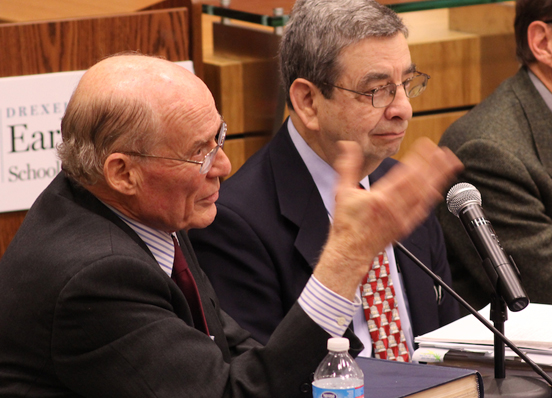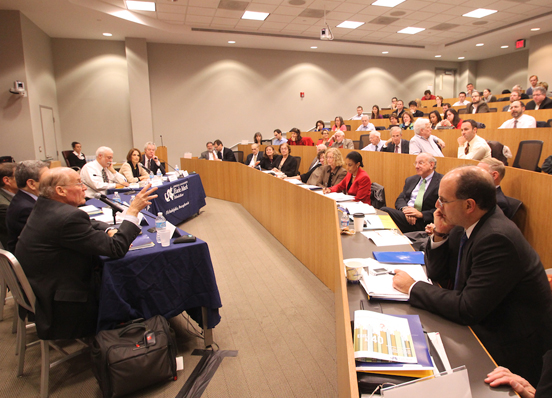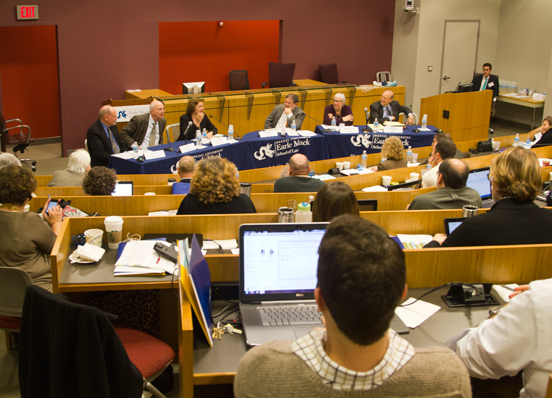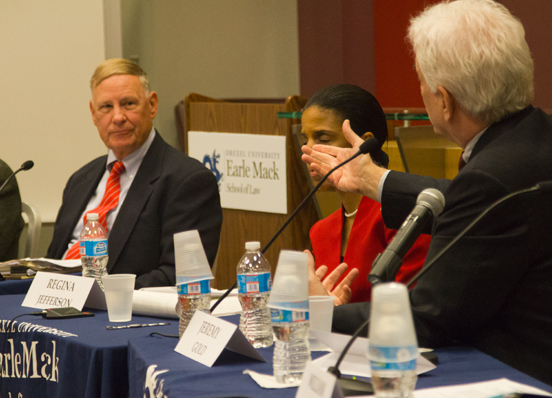Strategists in the quest to secure workers’ pension funds recounted efforts to woo industry and union leaders and quell Congressional turf wars that surrounded the passage of the Employee Retirement Security Act at a symposium hosted by the Drexel Law Review on Oct. 25.
Nearly a decade in the making, ERISA was “a legislative miracle” and “a magnificent piece of social welfare legislation” that has affected the lives of “literally millions of people,” said Professor Norman Stein.
A leading authority on pension law, Stein organized the conference with James Wooten, a professor at SUNY-Buffalo Law School and the author of “The Employee Retirement Security Act of 1974: A Political History.”
The symposium, in which panels of scholars and practitioners elicited remarks from leaders of the battle to pass ERISA, compiled an oral history of the legislation in time for the 40th anniversary of its passage.
Prior to ERISA, employees would work a very long time reasonably expecting to get a pension and then ended up getting nothing, said Frank Cummings, the former chief of staff to Senator Jacob Javits, who wrote an initial draft of the law. The trick was figuring why this was happening, Cummings said, adding that varying retirement ages and rules, a lack of recourse for under-funded pensions and scant fiduciary standards were principal culprits. 
Daniel Halperin, Stanley Surrey Professor of Law at Harvard University, who served at the U.S. Dept. of Treasury prior to ERISA, said there were really few protections for employees and that minimum funding rules were inconsequential and did not address past-service liabilities.
Beyond the technical obstacles, ERISA also lacked political support, Cummings and Halperin stressed. ERISA “didn’t have the support of anybody but the people,” Cummings said, adding that the press did not pay much attention to it either until Cummings and Javits held hearings that revealed horror stories of individuals losing their pensions.
Calling Javits “the mastermind,” former Department of Labor Solicitor William Kilberg recounted that the lack of support for reforms within the powerful Department of Commerce should have doomed ERISA.
“This is a bill that never should have come to being,” Kilberg said.
 Once passed, Congressional tax and labor committees competed for jurisdiction over ERISA’s administration, said Robert Nagle, who was general counsel to the Senate Committee on Labor and Public Welfare during the early 1970s and later the executive director of the Pension Benefit Guaranty Corporation, the organization created to provide insurance for defined benefit plans.
Once passed, Congressional tax and labor committees competed for jurisdiction over ERISA’s administration, said Robert Nagle, who was general counsel to the Senate Committee on Labor and Public Welfare during the early 1970s and later the executive director of the Pension Benefit Guaranty Corporation, the organization created to provide insurance for defined benefit plans.
Even when broad support emerged for ERISA’s reforms, no one could agree on who would administer the law, Wooten said.
Eventually, the law gave responsibilities to both the Treasury and Labor departments and the newly formed PBGC, but opened the door to bureaucratic confusion and necessitated enactment of Reorganization Plan Number 4, a blueprint for allocating primary regulatory authority for different aspects of the state to Treasury and Labor, according to Alan Lebowitz, who is now deputy assistant secretary of the Department of Labor.
“The concepts were very new and somewhat vague,” Lebowitz said during a panel facilitated by Assistant Secretary of Labor Phyllis Borzi and Deputy Assistant Secretary of Treasury Mark Iwry. 
“It’s hard enough within a single agency to sort through all the ideas people have,” said Lebowitz, who worked for the Internal Revenue Service (part of the Treasury Department) at the time.
The skeleton of the reorganization plan was mapped out on a napkin over a Chinese food lunch between Dianne Bennett, who served as an attorney for Treasury, and Ian Lanoff, who then served as administrator for Pension and Welfare Programs at the Department of Labor.
The reorganization plan had a lasting effect, Borzi said, noting that it created a model for inter-agency cooperation that continued with the implementation of other reforms, such as the COBRA insurance program and the Affordable Care Act.
“We coordinate. We talk to each other,” Borzi said. “Is it a time consuming process? Yes.”
Educating the public about the complex issue of pensions is a challenge, New York Times reporter Mary Williams Walsh, former Wall Street Journal reporter Ellen Schultz and former New York Times reporter David Cay Johnston said during a lunch time discussion.
Journalists face increased pressure to be the first to report issues, Schultz said, and reporters must trim their stories ever shorter, Walsh added, identifying trends that discourage in-depth and accurate reporting on policies that affect millions upon millions of workers and retirees.
The tendency to refer to pensions in terms of “benefits” or “gratuities” obscures the fact that pensioners have earned the money, Johnston said.
“These are not welfare programs,” he said. “We need to get away from language that describes these as ‘contribution’ or ‘benefit. It’s compensation.”
Former PBGC General Counsel Henry Rose and former PBGC Executive Director Robert Nagle joined Cummings in a discussion of the origins of ERISA’s definition of fiduciary, which was facilitated by University of Michigan Professor Dana Muir, O’Melveny & Myers Partner Bob Eccles and Stris & Maher Partner Peter Stris.
The important role of fiduciaries received scant attention from lawmakers in the House and Senate, who jockeyed with competing bills that focused on funding and termination of pension plans, Cummings said. He noted that fiduciary responsibility applied not just to investment and asset management, but the array of responsibilities that would be typical of a trustee.Congress focused less on the penalties fiduciaries would face for improperly administering a plan and more on how to actually administer it, Cummings said. However, if the Senate’s version of the final bill had prevailed, myriad lawsuits alleging under-funding and fiduciary misrepresentation could have been avoided, Nagle argued.
The discussion featured a spirited debate between Mueller and Damon Silvers, the director of policy and special counsel for the AFL-CIO, about approaches to funding. The law also could have done a better job with funding rules, Jeremy Gold, a consulting actuary suggested as he helped moderate a panel exploring the tax and minimum funding standards of ERISA. Russell Mueller, a past staff member actuary on the U.S. Houses Committee on Education and Labor who was involved in the early drafting of ERISA, agreed. However, Mueller argued, ERISA was remedial legislation, designed to address major pre-ERISA problems.
Although ERISA offered a real effort to offer remedies to pension participants, its enforcement provisions too had issues, Howard Shapiro, a seasoned ERISA litigator and partner at Proskauer Rose said while moderating a panel on benefit disputes and enforcement. Cummings, however, suggested that preemption was a greater issue for businesses and labor than remedies. Nagle noted broad preemption was introduced late in the stage and perhaps should have caused the drafters to refocus on federal remedies given that state remedies would now be foreclosed.
Despite its shortcomings, ERISA achieved a radical change in pension administration, Professor Norman Stein said. Understanding ERISA requires a perspective on how issues arose and how lawyers and the law dealt with them, Steven Sass, director of the Financial Security Project, Retirement Research Center at Boston College said. Cummings stressed that ERISA was designed to address the problems that we were facing at the time, not to anticipate problems that would arise in the future.
Calling the symposium “an amazing gathering,” Iwry said it was effective at “capturing incredible war stories and real history” of those who grapple with congressional turf, power struggles and their aftermath in the ongoing work of government.